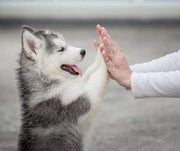The Three Rules to Training

When people tell me they can't train their out-of-control dog, I tell them to remember three words in this order: Control, Train, Treat. Let's break this down step by step!
Control: It's very typical for a puppy or any untrained dog to be wild and out of control. It's frustrating to most people when they're trying to train them and the dog is running wild all over the place. This is equivalent to a teacher trying to teach in a classroom full of kids but there are no chairs or desks. Much like the teacher gains more control over her students by having them sit at their desks, the same rule applies to training your dog. The simple solution to this is to leash them up. Done. Now I have 90% more control than I had 10 seconds ago. Now it's time to begin training.
Train: Now we have control and we start the training process. I always train in short but effective sessions. I don't ever want to overwork them and in turn, make them hate it. When we train, it's vital to teach the animal the correct technique for each behavior. This can and will confuse them if not done correctly, and very quickly you could find yourself going back a couple steps rather than forward.
Treat: After we've gotten control of our animals and trained them, it's time to treat them. Rewarding our animals is extremely important in the training process. It's also key to reward them right after they do the behavior you have asked. The more demanding the behavior you train, the better the reward should be. Be careful not to reward your dog with treats every time. This could make them food-dependent, which causes them to listen only when food is involved. It's important to mix up your reward with food, love, and toys. The toy reward you give should be dependent on your dog's play style. Another added benefit to this approach is the bonding time you will have with your pet.
You'll see me use this same three-step training strategy every week on Lucky Dog. They are the rules I live and train by. I always recommend you consult a qualified trainer. I'd recommend Brandon McMillan, who's been training professionally for 20 years. That's right 2-0. Here, lemme spell that out for you. Twenty Years.
Try them out on your dog and finally see the results you've been waiting for. Ruff!
– Brandon
For more training tips from Brandon, visit his blog at http://www.canineminded.com/.
Previous article

Next article

Related posts
View all-

Keep Your Pets Safe During the Holidays
The holiday season brings joy, festivities, and a break from the usual routine. While you're enjoying the celebrations, it's important to remember that the holidays can present unique challenges for our furry family members. The new sights, sounds, and people can be overwhelming, and common festive items can pose unexpected risks.
Read Article -

Holiday Gifts for Every Pet Personality: The Ultimate Guide
The holiday season is finally here, and for many of us, that means finding the perfect presents for the ones we love most—our pets. Whether they are a steadfast dog who never leaves your side or an independent cat who graces you with their presence on their own terms, our pets are cherished members of the family. They deserve to celebrate right alongside us, stocking stuffers and all.
Read Article -

How to Keep Your Pet Calm During Thanksgiving
Thanksgiving is a time for family, friends, and food, but for our pets, the holiday can be overwhelming. The sudden change in routine, unfamiliar faces and scents, and increased noise can trigger significant stress. Understanding why your pet might feel anxious is the first step toward creating a peaceful holiday experience for everyone, including your furry family members. This guide offers calming tips for pets and practical solutions to ensure your dog or cat feels safe and secure during the festivities.
Read Article



